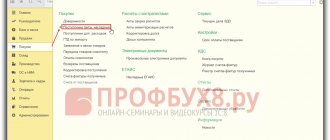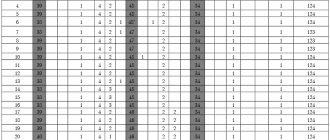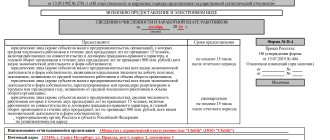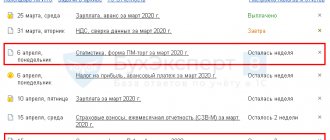The quarterly statistical report in the form ZP-education contains information about the number of employees in the educational institution and the payroll. The unified form and Instructions for filling it out are regulated by Rosstat Order No. 412 dated July 24, 2020 (Appendix No. 9).
The main purpose of the salary-education form is to collect statistical information on indicators of income from the labor activities of personnel. With its help, statistical authorities monitor indicators in a specific period of time. Educational institutions will begin submitting this report using the new form starting with reporting for the 1st quarter of 2021.
Where to submit the salary form - education
The place where the ZP-education form is submitted depends on the jurisdiction of the respondent. The report is submitted to the territorial body of Rosstat at the location and to the governing bodies in the field of education (according to affiliation) by those who are subordinate to:
- the local government body responsible for management in the field of education,
- the executive body of the constituent entity of the Russian Federation exercising management in the field of education,
- Ministry of Science and Higher Education of the Russian Federation,
- Ministry of Education of the Russian Federation.
The rest submit the form to the territorial body of Rosstat at their location and to their founder.
What are the penalties for false information, errors or failure to submit a form?
Responsibility for violating the procedure for submitting the form, violating deadlines, for submitting false data about employees and their salaries, errors in the entered data is described in the Law of the Russian Federation of May 13, 1992 No. 2761-I and in Art. 13.19 Code of Administrative Offenses of the Russian Federation.
A fine in the amount of 20–150 thousand rubles is imposed on a legal entity, and a fine in the amount of 10–50 thousand rubles on the responsible official (or persons). The organization compensates for damages from recording incorrect data to statistical authorities.
Keep records of exports and imports in the Kontur.Accounting web service. Simple accounting, payroll and reporting in one service.
How to make changes to documents and set the correct deadlines for paying wages
If for some reason you do not have LNA regulating the timing of salary transfers, they need to be done as quickly as possible. If the necessary LNAs exist, but the dates in them are indicated incorrectly, this should be promptly corrected:
- If possible, redo the document, but only if doing so will not cause inconsistencies with your other documentation.
- In order to change the collective agreement, assemble a commission of representatives of both parties - employees and employer. Document the results of the negotiations between the commission members in an additional agreement, in which you indicate the new salary terms.
- If salary dates were included in employment contracts, you will have to draw up additional agreements for each of them.
- Changes in the terms of payment of wages included in the PVTR are the easiest to formalize - to do this, it is enough to issue an order, which should be familiarized to each employee against signature.
You can see what such an order looks like here:
What is a balance sheet application?
Form 5 is an additional explanatory annex to the balance sheet itself, created in order to justify its sections and some of their provisions.
The balance sheet supplement is a clarifying type of documentation. At one time, they tried to cancel it, limiting themselves to providing explanations only with an explanatory note, which led to confusion in the data that should or should not be included in the documents, so the form was returned as an accompanying document to the balance sheet.
This form serves to reveal in more detail the balance sheet indicators that are displayed in it and to create a more understandable picture of the financial situation at a given enterprise.
Moreover, these indicators will be divided into types and groups depending on financial affiliation.
The groups by which the division will occur are as follows:
- Intangible assets.
- Fixed assets after reflecting depreciation.
- Investments in valuables of a material nature in the authorized funds of other organizations, bonds, etc.
- Expenses for ordinary activities, for design developments, for the development of natural resources.
- Debts of different types.
- Subsidies received from the state.
Watch the latest video about filling out financial statements:
What to consider when setting payroll dates
Before approving salary dates, consider the possible risks and tax consequences. There are a number of slippery points that you should pay attention to:
- The expressions “every half month” and “twice a month” should not be confused. For example, the numbers 3 and 16 fit the definition of “twice a month,” but the rule of not exceeding a gap of 15 days is not followed here, since from the 16th to the 3rd it is more than half a month.
- It is dangerous to choose not clear dates, but a time period - for example, from the 1st to the 5th, as well as deadlines, for example, no later than the 5th and 25th. Firstly, Art. 136 of the Labor Code of the Russian Federation speaks of the need to establish specific dates, and secondly, there is a risk of confusion and exceeding the six-month interval between payments. The illegality of this approach is stated in the letter of the Ministry of Labor of the Russian Federation dated November 28, 2013 No. 14-2-242, the resolution of the Supreme Court of the Russian Federation dated May 15, 2014 No. 3-AD14-1, the ruling of the Trans-Baikal Regional Court dated September 5, 2012 No. 33-2867-2012.
- An insufficiently defined phrase will also be unsafe, for example: “salaries are paid no later than the 5th and 20th of each month.” After all, it is impossible to understand from such a phrase when an advance is given and when the final amount is given.
- When choosing convenient dates, you need to take into account the requirements of the Tax Code of the Russian Federation. Thus, the 15th day for the final payment turns out to be inconvenient, since the advance payment in this case falls on the 30th day, and this is the last day in many months. From the advance paid on the last day of the month, personal income tax will have to be withheld (clause 2 of Article 223 of the Tax Code of the Russian Federation, determination of the Supreme Court of the Russian Federation dated May 11, 2016 No. 309-KG16-1804). But in months that have 31 days, this is not necessary. This will create confusion for both the accountant and controllers.
To learn how to reflect the tax withholding date in 6-NDFL, read this article.
Is it permissible to pay salaries more than twice a month?
Yes, definitely. The Labor Code directly states that salaries are paid “at least every half month.” This means that restrictions are placed only on rarer payments to employees, but not on more frequent ones (letters from the Ministry of Labor of the Russian Federation dated 02/03/2016 No. 14-1/10/B-660, dated 12/06/2016 No. 14-1/B-1226 ).
If you wish, you can issue money not twice a month, but weekly and even daily. However, before switching to a more frequent frequency of salary payments, it is worth considering the feasibility of this: whether such a schedule will be convenient and beneficial for both employees and the employer himself.
Practice shows that this is beneficial for those employers who employ temporary staff; in other cases, the benefits of more frequent payment of money are completely unobvious, if not completely absent.
For information on how to conclude an agreement with a temporary worker, read the material “Art. 59 of the Labor Code of the Russian Federation: questions and answers.”
The weekly payment does not excite the staff either: according to repeated statistical surveys, the majority of employees would like to maintain a 2-time salary schedule.
Appendix 0. DEPARTMENTAL STATISTICAL REPORTING
DEPARTMENTAL STATISTICAL REPORTING
Presented in accordance with Articles 7 and 12 of the Law of the Republic of Kazakhstan “On State Statistics”
—————————————————¬ ¦ CODES ¦ +——T———T——T——-T———T———+ ¦ 1¦ 2 ¦ 3 ¦ 4 ¦ 5 ¦ 6 ¦ +——+———+——+——-+———+———+ ¦register-type forms ¦Mini- ¦organi- ¦territo¦ ¦document- ¦rational ¦entrepreneurship¦national-¦ria according to ¦ment¦number ¦association¦(departmental¦legal ¦SOAT ¦ ¦on ¦economic ¦(KTP) ¦stvo) ¦forms according ¦ ¦ ¦OKUD ¦going ¦ ¦according to ¦KOPF ¦ ¦ ¦ ¦subject ¦ ¦SOOGU ¦ ¦ ¦ ¦ ¦ (OKPO) ¦ ¦ ¦ ¦ ¦ L——+———+——+——-+———+——— Table continued : ————————-¦ T——-T——T———+ ¦ 7 ¦ 8 ¦ 9 ¦ +——-+——+———+ ¦industries¦sectors-¦forms ¦ ¦according to OKED¦or according to ¦own-¦ ¦ ¦OKONKH ¦according to ¦ ¦ ¦ ¦KFS ¦ ¦ ¦ ¦ ¦ ¦ ¦ ¦ ¦ ¦ ¦ ¦ ¦ +——-+——+———-
Form No. 1 Approved by Resolution of the National Statistical Agency of the Ministry of Economy and Trade of the Republic of Kazakhstan dated June 2, 1997 No. 30
ANNUAL - POSTAL
Present:
1. National Securities Commission of the Republic of Kazakhstan legal entities issuing non-government securities, no later than the 20th day of the first month of the year following the reporting one.
2. To the National Statistical Agency of the Ministry of Economy and Trade of the Republic of Kazakhstan NSC no later than April 1 after the reporting period.
__________________________________________________________________ To whom is ________________________________________________ name and address of the recipient
Ministry, joint stock association, holding, concern, association _____________________________________ ___________________________________________________________________
Enterprise, institution, organization ___________________________________ ___________________________________________________________________
Address ____________________________________________________________ Form of ownership _____________________________________________
Kind of activity _________________________________________________
Number and date of registration of the last issue _______________________
Date of approval of the report on the results of the last issue ______________ ___________________________________________________________________
REPORT ON THE RESULTS OF THE ISSUER'S ACTIVITIES ON THE SECURITIES MARKET for the period from ______________ to _____________ 199__.
———-T——-T——-T——T——T————T ¦Organization-¦JSC Type ¦Size ¦Amount ¦Amount ¦List ¦ ¦tional - ¦(open-¦statute- ¦ long-term paid-out shareholders, legal, fixed-term holding, form of closed-end fund, dividends, more than 5% (tenge) credits ¦ ¦ ¦ ¦ ¦dits ¦ (ten- ¦papers from ¦ ¦ ¦ ¦ ¦ (ten- ¦ge) ¦statutory ¦ ¦ ¦ ¦ ¦ge) ¦ ¦fund ¦ L———+—— -+——-+——+——+————+ Continuation of the table: ——T———T——¬ General ¦Name-¦Note-¦ number ¦notations ¦ action-¦register-¦ ¦ uneven ¦ holder ¦ ¦ ¦ ¦ ¦ ¦ ¦ ¦ ¦ ¦ ¦ ¦ ¦ ——+———+——- —-T—T—T—T——T——-T———— T—T ¦ ¦shares ¦name, ¦ ¦ ¦ ¦ ¦ ¦ ¦ ¦ ¦address) ¦ ¦ +—+—+—+—+——+——-+————+—+ ¦ A ¦ B ¦ 1 ¦ 2 ¦ 3 ¦ 4 ¦ 5 ¦ 6¦ L—+—+—+—+——+——-+————+—+ Table continuation: ————T—T—T—-T—-¬ Individuals (full name, full name, passport details) -+—-+ 7 ¦ 8 ¦ 9 ¦ 10 ¦ 11 ¦ ————+—+—+—-+—— Manager _________________ Chief Accountant _______________ » ___ » ____________ 19 __ year _________________________________ name and telephone number of the performer
The main sources of published texts of regulatory legal acts: the Kazakhstanskaya Pravda newspaper, the database of the Adviser legal reference system, Internet resources online.zakon.kz, adilet.zan.kz, and other media on the Internet. Although the information has been obtained from sources we believe to be reliable and our experts have used every effort to verify the accuracy of the received versions of the texts of the cited regulations, we cannot make any confirmations or guarantees (whether express or implied) regarding their accuracy. is not responsible for any consequences of any application of the language and provisions contained in these versions of the texts of normative legal acts, for the use of these versions of the texts of normative legal acts as a basis, or for any omissions in the texts of the normative legal acts published here.
Preparation of financial statements in general is a very complex and painstaking process. It is important not only to correctly display data in reporting documents, but also to correctly compose the document. The legislation imposes certain requirements on the appearance of these documents and their structural content. In this article we will look at Form 5 of the financial statements.
What documents indicate the days of payment of wages?
The employer is obliged to fix a specific schedule for the transfer of salary money in its local regulations (LNA): internal labor regulations (ILR), collective or labor agreement. It is these 3 documents that Art. 136 Labor Code of the Russian Federation.
The wording of this article is designed in such a way that the question often arises: is it necessary to fix salary terms in all of the above documents or is one of them sufficient? The answer to it was repeatedly given by both officials and judges (letter of Rostrud dated March 6, 2012 No. PG/1004-6-1, ruling of the Moscow City Court dated December 24, 2012 No. 4g/5-12211/12).
For information on what to include in an employment contract, read the article “Procedure for concluding an employment contract (nuances).”
According to the explanations, it is enough that the deadlines are fixed in one of those given in Art. 136 Labor Code of the Russian Federation documents. Moreover, according to Rostrud, PVTR is a priority. He explains this by saying that the PVTR is a general document, the norms of which apply to all personnel, while an employment contract regulates relations with a specific employee, and a collective agreement may not be concluded at all.
In order to completely eliminate disputes with inspectors, you can do the following: fix the rules for issuing wages in the PVTR, and add a phrase in labor or collective agreements that refers to the PVTR: “salaries are issued in accordance with clause (here we indicate the clause number of the PVTR) of the rules labor regulations..."
Is it legal to pay wages ahead of schedule?
It is only legal if the payday falls on a weekend. In other cases, despite the fact that there is no violation of the rights of employees, it is not recommended to pay money earlier than approved by the employer’s LNA. This is fraught with claims from the labor inspectorate and the imposition of a fine.
As we have already found out, the Labor Code of the Russian Federation requires that the dates of payment of wages be clearly recorded in the employer’s LNA. By paying wages ahead of the approved date, strictly speaking, you will have to make appropriate changes to the LNA. However, it is unlikely that anyone will think about a global reworking of documents if the manager occasionally wants to meet employees halfway and issue, for example, a salary before the holidays (while the salary payment period falls on the day after the holiday). In addition, this may lead to an increase in the half-month period between payments, which is also not allowed.
Therefore, although the manager allowed the earlier payment of wages in the interests of the employees themselves, formally this situation is considered a violation (Part 1 of Article 142 of the Labor Code of the Russian Federation) and may lead to fines (Part 1 of Article 5.27 of the Code of Administrative Offenses of the Russian Federation). However, the risk of prosecution here is still small.
What does the Labor Code of the Russian Federation say about the timing of payment of wages in 2020?
Salary terms are fixed in Art. 136 Labor Code of the Russian Federation. According to it, money for employees’ work should be transferred to:
- at least every half month, and
- no later than 15 calendar days from the end of the period for which the payment was accrued.
If the salary date approved by the employer falls on a weekend, the money is issued the day before.
IMPORTANT! Norms Art. 136 of the Labor Code of the Russian Federation are mandatory and cannot be violated even at the written request of an employee who wishes to receive money once a month.
As a rule, employers pay wages according to the following scheme: once a month they issue an advance and once a month the final payment, adjusted to the previously issued advance. With such a schedule and taking into account the norms of Art. 136 of the Labor Code of the Russian Federation, the deadlines for salaries for the first half of the month fall on the 16th–30th (31st), and for the second half - on the 1st–15th.
IMPORTANT! For large companies with a large number of structural divisions and a large staff, it is not prohibited to approve different salary payment dates for different departments (letter of Rostrud dated June 20, 2014 No. PG/6310-6-1).
All aspects of paying advances to new employees are in the article “Advance to a new employee in the first month of work.”








